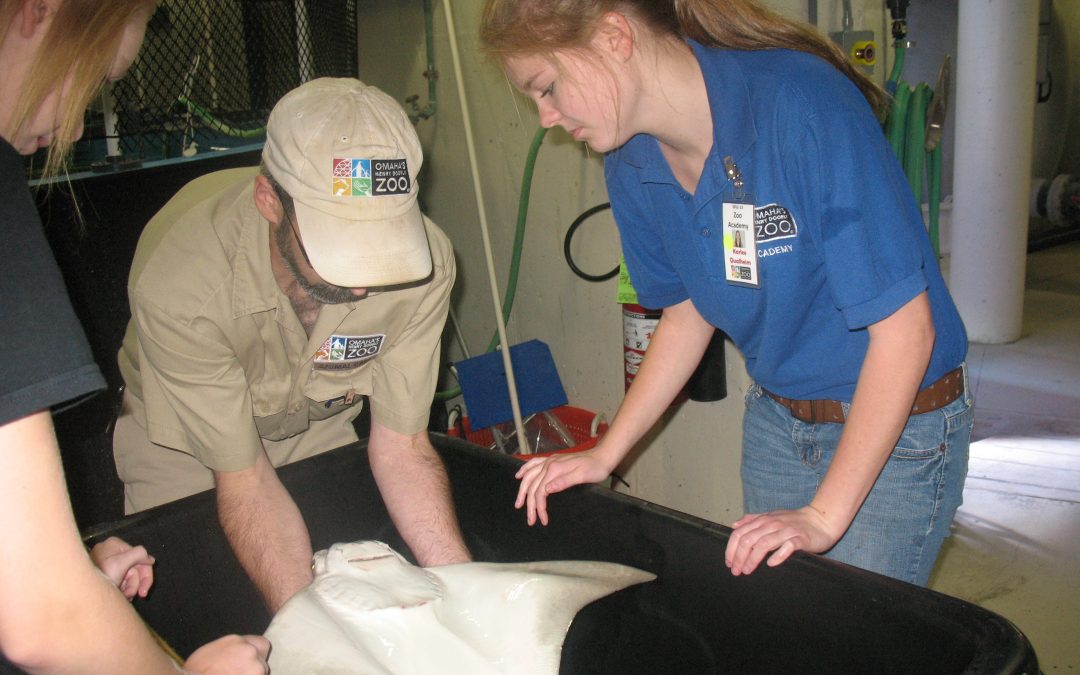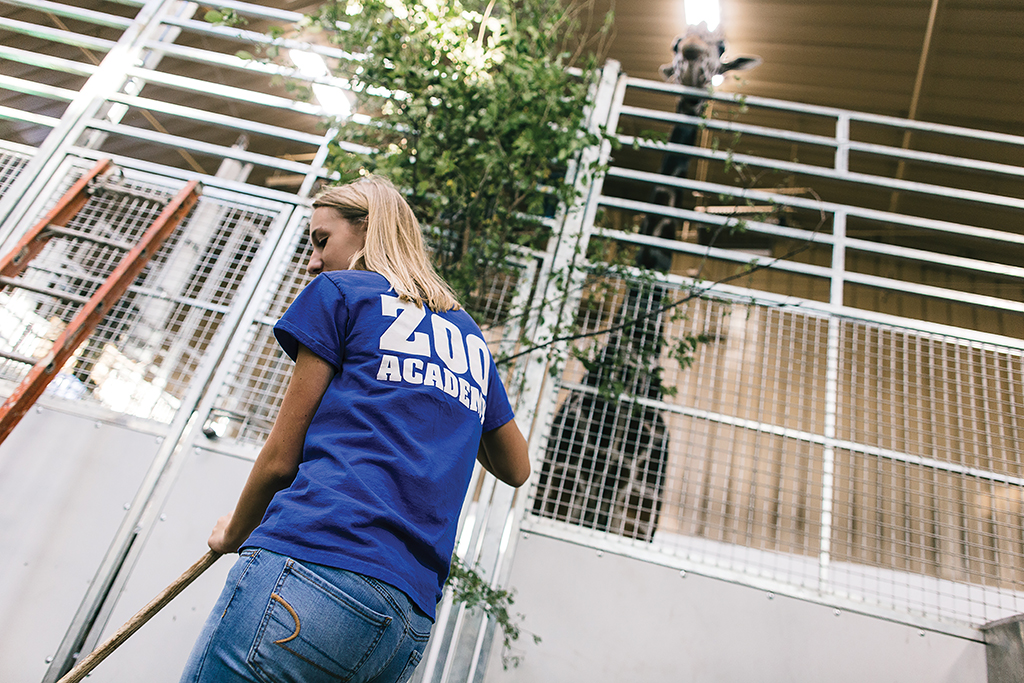By. Jackie Halsey and Dr. Elizabeth Mulkerrin
Omaha’s Henry Doorly Zoo and Aquarium has been a strong and active partner in education for over 40 years, educating 2.1 million visitors annually. The zoo is a leader in informal and formal education, pioneering many science, technology, engineering, and mathematics (STEM) initiatives. In 1996, the zoo stepped up its game and began collaborating with a diverse group of education institutions. The zoo discovered that successful partnerships require multiple organizations coming together and sharing resources for a cause. In partnering with school districts, the zoo offered expertise to assist with curriculum development, teacher content knowledge development, and PreK–12 formal education programs. Over time, the zoo, local school districts, and the community realized they shared common goals in education and were working toward creating STEM-rich learning environments for all. This realization led to the formation of a more collaborative relationship in which everyone was equally involved in creating and implementing STEM-rich education opportunities for students. One of these opportunities is Zoo Academy.
Exploring Careers in Conservation and Animal Science
Today, more than a half a dozen local school districts send 120 students to High School Zoo Academy each year. Omaha Public Schools and Papillion LaVista Community Schools provide full-time teachers while zoo staff collaboratively create zoo-specific curriculum, externships in zoo career fields, and research-driven student projects. Zoo Academy’s mission is to provide students with knowledge and career explorations relating to life science through authentic STEM experiences at the zoo. Not only does the zoo provide real-world experiences to students through its many departments, but students also work closely with local veterinary clinics. Opportunities range from developing new animal care techniques to advocating for the protection and promotion of a healthy planet for animals.
Students who attend Zoo Academy go through a rigorous application process prior to acceptance. Applicants must write a 500-word essay on a conservation issue that is important to them, as well as an essay that talks about how Zoo Academy will benefit their future career plans. From there, students are interviewed by a small panel of zoo staff. This panel includes Zoo Academy teachers, animal care staff, and zoo education team members. Students also provide three references to complete a recommendation form. All three components (application, interview, and references) are evaluated and scored. A ranking is compiled, and students are accepted into the program based on their final rankings and the number of first-year spots available. Over 140 applications were submitted for the 2021 – 2022 school year.
The benefits of attending Zoo Academy are endless. From the first day students begin to build an impressive resume of experiences. Some of these experiences include conducting research with notable scientists, participating in animal medical procedures, and communicating relevant conservation issues to the community. After completing their zoo courses, students have a plethora of references they can tap into from working with zoo staff.
Zoo Academy offers courses for two distinct STEM career pathways: Conservation Research and Animal Science. These pathways give students the opportunity to explore a variety of conservation research and wildlife careers. The courses in each pathway are designed to develop the work skills and knowledge students need to pursue internships and careers in conservation biology, conservation genetics, wildlife and zoo management, exhibit design, ecology, conservation research, and veterinary science.
Zoology, Conservation Research, and Veterinary Science courses include a work-based experience course. Animal care experiences take place at the zoo. Students work directly with animal care staff in the Walter and Suzanne Scott Aquarium, Lied Jungle, Mutual of Omaha Wild Kingdom Pavilion, Desert Dome, and Amphibian Conservation Center. In each area, students learn firsthand about animal management, horticulture, conservation, and many other zoo-related topics and professions. Conservation research work experience students work directly with our reproductive physiologists, a nutritionist, and a geneticist to assist with zoo research and design their own conservation research study. Over the years, these high school students have become first authors on scientific publications and have returned to complete their Ph.D. programs with their zoo mentors. The veterinary science work experience course provides students with opportunities to learn about a range of options in animal care fields. Students spend their time at the zoo working directly with zoo veterinarians and veterinary technicians and in several Omaha veterinary practices. Students learn firsthand about the basics of veterinary practice and lab procedures for domestic and exotic animals. Elisa, a current Zoo Academy student, states, “The many amazing opportunities you receive during shadowing have helped me gain a bigger perspective on the career field I want to go into.” Elisa is currently finishing up her coursework to become a vet.
Students are not the only ones who benefit from Zoo Academy. The scientific community also benefits, with most program participants pursuing STEM fields after graduation. Zoo Academy alumni move into postsecondary programs in STEM fields related to agriculture and natural resources (35%), scientific research and engineering (35%), and health services (17.6%). The school districts involved in the program can better meet their education goals by providing relevant skill development opportunities and a rigorous, up-to-date curriculum, all in a facility they wouldn’t have access to without their collaboration with the zoo.
Finally, the zoo benefits because Zoo Academy students often become future employees, given they have spent nine months developing the knowledge and skills needed to work in many positions at the zoo. Several Zoo Academy alumni work in multiple departments throughout the zoo. Jocelyn, a 2006 Zoo Academy alumni, states, “Zoo Academy played a pivotal role in my journey to becoming a conservation educator, and eventually Education Manager of Visitor and Volunteer Engagement at Omaha’s Henry Doorly Zoo and Aquarium. During Zoo Academy, I learned about zookeeping and the various conservation career paths at the zoo. I was given the opportunity to rotate around different animal areas and work alongside educators and animal care staff behind-the-scenes. At the end of the year, I joined classmates on a life-changing trip to Costa Rica where I learned about conservation field projects. The hands-on and eye-opening experiences I had with Zoo Academy inspired me to devote my career to conservation and gave me the necessary tools to one day educate the next generation of youth as they travel along their own paths to STEM and conservation careers.”
Zoo Academy and COVID-19
The 2020 – 2021 school year has brought many challenges for teachers, students, and administrators to keep Zoo Academy relevant and engaging. The program remained open and running, even while the zoo was closed due to COVID-19. Teachers and zoo staff came together and adapted in-person interactions for virtual learning. Having the digital learning platform Canvas already in place prior to the pandemic helped Zoo Academy teachers stay connected to students during the zoo’s closure. While students were not able to get dirty by doing, they were able to see animal husbandry in action by watching how animal care staff cared for and managed wildlife. Students were also able to engage in conversations with zoo experts to build their understanding and knowledge of various zoological careers. Zoo Academy science teacher Amy Leising helped her students make real-world connections between the pandemic and her Veterinary Science courses. “I think one of the most relevant things we have covered is our Animal Health and Safety unit which includes zoonotic disease. It was a direct connection to SARS Co-V 2 since it is zoonotic. Students learned about disease transmission and read articles in class about COVID-19 infections in big cats and mink at other zoos and animal facilities. They were able to understand and see the precautions our zoo put in place (like barriers between people and bats, cats, and primates) to protect our staff and animals.”
Tess Sykes, Zoo Academy English teacher relates, “I think Zoo Academy was better positioned to handle the move to digital teaching back in March because we already had a digital classroom management program in place with Canvas. Students were comfortable looking online for communication, assignments, and quizzes. This flattened the learning curve for being able to access the information and turn in assignments or give feedback.”
Zoo Academy staff have also been working to help keep students on track for college and careers after graduation despite the upheaval of COVID-19. The Zoo Academy teaching team hosted virtual college fairs for students, inviting colleges from across the country to host virtual presentations and question and answer sessions. These virtual presentations allowed students to get a glimpse of different college campuses and learn what each one was doing to keep students safe during the pandemic. These virtual fairs have been a big success with students. According to Reghan, a current Zoo Academy student, “I had the opportunity to speak with Iowa State’s veterinary program director to gain information on an education path that suits me best. This provided me with real-world connections to better my communication skills and improve my academic success. I was really excited to get a glance at what my future may look like. “
While the remainder of the school year is sure to keep teachers on their toes, there are many things to look forward to when it comes to teaching and learning. In 2021, the Zoo Academy team is eager for students to be able to continue their work-based experiences at veterinary clinics, in animal areas at the zoo, and in research. Looking toward the future, we hope to expand and grow our program to include more virtual courses and experiences for students across Nebraska.
Author Bios
Jackie Halsey joined Omaha’s Henry Doorly Zoo and Aquarium as Program Manager of Formal Education in December 2019. Prior to her position at the zoo, she taught middle school science and social studies in both Omaha Public Schools and Elkhorn Public Schools for six years. She holds a Bachelor of Science in Education and a Master of Science in Secondary Education with a science concentration. As Program Manager of Formal Education, Jackie oversees the zoo’s middle and high school Zoo Academy programs and its full-time preschool program, Little Lions. She also manages school field trips and student workshops and helps maintain grant-funded partnerships the zoo has within the community.
Dr. Elizabeth Mulkerrin was named Vice President of Education at Omaha’s Henry Doorly Zoo and Aquarium in 2000. She began her career in secondary science education as a biology teacher from 1994 – 2000. Dr. Mulkerrin is responsible for establishing, promoting, and maintaining formal and informal education programs. This includes managing over 1,200 volunteers, managing distance learning programs, developing curriculum, and overseeing the High School Zoo Academy, Middle School Zoo Academy, and Zoo Kindergarten.




